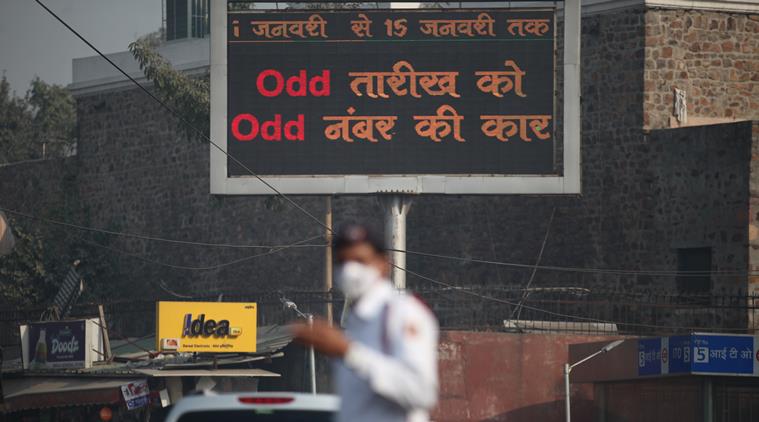Stay updated with the latest - Click here to follow us on Instagram
Even on Day Two, Delhi’s clean air plan seems to work
"Mere rules can not change anything, change of mindset is needed which we aimed at through implementation of odd-even formula," said Rai.
 Motorists at the ITO (New Delhi) undergo a Delhi govt odd-even trail run early Thursday morning, during which the traffic policemen and Civil defense members managed the traffic and held out posters narrating about the traffic arrangements to be starting this new year. (Express Photo by Tashi Tobgyal)
Motorists at the ITO (New Delhi) undergo a Delhi govt odd-even trail run early Thursday morning, during which the traffic policemen and Civil defense members managed the traffic and held out posters narrating about the traffic arrangements to be starting this new year. (Express Photo by Tashi Tobgyal)
On Saturday, Day 2 of Delhi’s odd-even road-rationing policy to combat air pollution, even-numbered cars rolled out — and the experiment seemed to continue to work. With not many violations reported through the day, and with even fewer reports of traffic congestion, the Delhi government claimed late in the evening that after two days of the intervention, pollution levels had fallen in the city.
Deputy Chief Minister Manish Sisodia, who uses an odd-numbered car, cycled to the All India Radio (AIR) office from his Mathura Road residence at 8.30 am. He took questions from callers on the odd-even policy, and then rode to the Delhi Secretariat.
WATCH VIDEO
Transport Minister Gopal Rai, who boarded a DTC bus to check on preparations and its working, said that “a new, collective consciousness” was visible. He took a two-hour round trip from and to the Delhi Secretariat.
“Mere rules cannot change anything, a change of mindset is needed, which we aimed to do through implementation of the odd-even formula. Two days of trials show that the people of Delhi are ready for it,” Rai said.
By evening, the Delhi Police had booked 229 cars for violating the policy, and the Transport Department had fined 47 drivers. On Friday, these figures were 138 and 65, and the police had been expected to intensify their drive on Saturday. The police also hauled up 208 autorickshaws for refusing to ply.
READ: More traffic personnel, volunteers deployed on Day 2
Sources in the government said that they would assess data and reports from the across the city over the first two days of the odd-even policy. “Though successful, the big test is on Monday. For two days, traffic was expected to be less on account of holidays. On Monday, courts, offices and all government services will resume,” a senior government official said.
According to Rai, the lack of adequate public transport and safety were the reasons why two wheelers and women driving alone had been exempted. “We might consider including women under the rules after the review of the 15-day public movement,” he said.
ALSO READ: READ: Delhi on Day One: The Oddacity of Hope
“This 15-day rule is a pilot project. We intended to make it a public revolutionary movement without which it would not have been possible. After the 15-day period, we will review the response and the effect of the drive and accordingly decide on the next course of action,” Rai said.
Late on Saturday evening, the Delhi government released air quality monitoring data, and claimed a dip in particulate emissions — PM 10, which is smaller than 10 microns in diameter, and PM 2.5, which is smaller than 2.5 microns in diameter.
Based on data of particulate matter collected from 24 locations on January 1, the Delhi Pollution Control Committee (DPCC) claimed that the levels of both PM 10 and PM 2.5 had dropped in comparison with the same dates last year.
While areas like Dyal Singh College and colonies like Kasturba Nagar recorded a particulate matter value of 149 micrograms per cubic metre, in colonies like Patparganj in East Delhi, the levels crossed 500 micrograms per cubic metre.
For each location, data on seven pollutants were collected for 20 minutes, and the average of that data was calculated, scientists said. According to the DPCC, on an average, PM 2.5 hovered around 250 micrograms per cubic metre. PM 10 was in the range of 149-503, according to data from the mobile machines.
According to the Delhi government, areas like Rohtas Nagar, Patparganj and Kondli, which border Uttar Pradesh, are showing higher levels of air pollution as compared to areas in the central parts of Delhi. Border areas like Anand Vihar, which bear the brunt of vehicular pollution, including entry of trucks from UP, are also showing higher pollution levels.
In a statement, the Delhi government said on Saturday evening that governments of NCR states “need to take immediate steps to supplement the efforts of Delhi government.”







